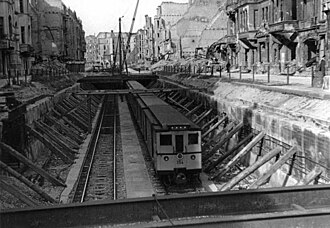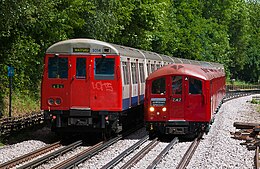Underlay
Unterpflasterbahn is a designation coined by Werner von Siemens for a tunnel in an underground , suburban train or underground tram , which runs directly below the pavement and was built using an open construction method.
history
The subterranean sections of the U1 , U2 , U3 or U4 lines in Berlin or the M1 of the Budapest metro , which originated from the early days of underground construction, are characteristic of underpaved railways . It was only later that the technical aids were developed in order to be able to create mining tunnels in deeper layers of soil even in difficult - for example sandy - soil conditions . The first tube railways , which run in a tunnel built using shield driving , existed in London towards the end of the 19th century.
Furthermore, underground stretches of light rail vehicles are partly designed as paving tracks, as in the Rhine-Ruhr area or in Cologne . Some of these routes, used by tram-like vehicles, were converted to full-subway operation, as is the case with line U2 of the Vienna subway .
Berlin construction

In order to reduce the necessary construction height, paving slabs are usually given a flat ceiling made of steel and masonry or concrete, the height of which can be further reduced using intermediate supports, as is the case with the construction of the Berlin subway , where the seal against groundwater is also remarkable . In the case of a very narrow street in which the paved road is located, the side walls of the paved tunnel are made from a combination of steel and masonry by connecting the steel components of the side walls and the ceiling to form a whole. The widening required at the stations can be achieved in the case of the paving strips by pulling the side walls apart using a thicker ceiling construction.
A sub-paving railway has specific advantages compared to an underground railway that was excavated by mining. This includes the small distance between the surface and the tunnel ceiling, which ensures that the routes to be built can be completed more quickly. This also applies to modernizations. The transfer time from the road surface to the platform is significantly shorter than at train stations in lower elevations with their branched access systems. The disadvantage is that in the case of paved railway stops, the access stairs usually only lead directly from the platform to the surface, so that in the case of central platforms they usually end in the middle of the tramway. In the case of side platforms, two separate access structures are required. Further disadvantages compared to a deeper location in the ground result from the construction directly below the road, since weather-related road damage can lead to damage to the track systems and the power supply infrastructure more quickly.

Furthermore, greening can only be carried out to a limited extent in the street areas on the tunnel (e.g. in buckets or raised beds) or supply media (cables, drinking or sewage pipes) can be added later. The physical proximity or the direct connection between the tunnel and buildings also affects the transmission of vibrations from moving underground trains, which are more clearly perceived.
Belgian construction

The Metro Paris was largely built also as Unterpflasterbahn. Line 1 , which went into operation in 1900 , was mainly built using the “Berlin construction method” with open construction pits. In order to keep the obstacles to surface traffic within limits in the future, shield driving was tried out , but this did not prevail. Instead, the “Belgian construction method” was used from now on, which deviated from the Berlin one. In order to avoid open construction pits, a pilot tunnel was created by mining, mostly at a shallow depth below the road surface . This was expanded on both sides and at the same time a stable vault was built. Only then was the tunnel deepened, which explains the typical cross-section of many Parisian routes. Some of the stations, for example the Porte d'Orléans station opened in 1909 , were still built using the open construction method.
Underpaving in other European countries
In London, four are underground -line Sub paving paths ( sub-surface lines expected), including with the Metropolitan Railway (section of today's Metropolitan Line ), the first subway in the world. The majority of the London routes, however, were built as tube lines . The two systems have a significantly different clearance profile .
The second oldest subway in the world, the Földalatti in Budapest , built by Siemens & Halske and commissioned in 1896, was also an underground railway . The Glasgow subway was built in 1896 partly as an under-paving and partly as a tube railway.
In Vienna, the routes of the former Viennese steam light rail , which opened in 1898 and which was incorporated into the Vienna Electric Light Railroad in 1925 and is now part of the Vienna U-Bahn , are partially designed as paving-stones.
Individual evidence
- ↑ Sabine Bohle-Heintzenberg: Architecture of the Berlin elevated and underground railway / planning - drafts - buildings. Verlag Willmuth Arenhövel, Berlin 1980, ISBN 3-922912-00-1 , p. 20.
- ↑ Biagia Bongiorno: The stations of the Berlin elevated and underground railway. Published by the Berlin State Monument Authority. Imhof Petersberg 2007, ISBN 978-3-86568-292-5 , p. 22.
- ^ Jean Tricoire: Un siècle de métro en 14 lignes. De Bienvenüe à Météor . 2nd Edition. La Vie du Rail, Paris 2000, ISBN 2-902808-87-9 , p. 39 .
- ^ Christoph Groneck: Metros in France . 1st edition. Robert Schwandl, Berlin 2006, ISBN 3-936573-13-1 , p. 54 .
- ^ Jean Tricoire: Un siècle de métro en 14 lignes. De Bienvenüe à Météor , p. 39 ff.

